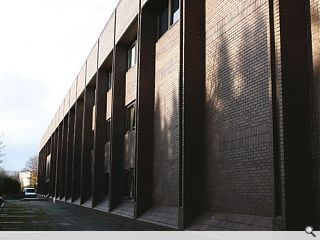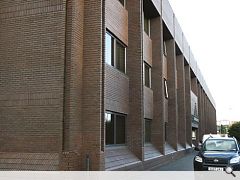Police Estate
14 Jan 2010
In a climate of increased fear of crime and terrorism stoking the need to accommodate ever stricter security measures, are we protecting against a one in a million chance of a terrorist attack or are we sacrificing the approachability and contact that everyday policing provides?
Gate houses, bollards, CCTV, perimeter fencing, blast proof walls and crackdowns on photographers are becoming increasingly common sights around our police estates. Might indirect measures such as a reconfiguration of space and passive overlooks break down not only the physical walls and barriers which have sprung up but bridge the psychological gulf between the public on the outside and their servants within?Douglas Anderson, Property Services Manager for Strathclyde Police, said: "I have striven to break down some of the barriers traditionally associated with Police buildings and givenÊmost of the reception areas in particular an overhaul that allows the public to be received in a more open way. Key design solutions were promoted to improve access for the disabled, improve information availableÊand provide suitable security to staff. Security remains a high priority as these buildings hold important intelligence and evidence that are vital to the process of justice.'
It is into this context that a critical report from property consultancy Drivers Jonas has emerged, raising questions over the estates management of one of the largest Forces in the country, Strathclyde. The Force covers some 146 properties, 60% of which are over 30 years old but further estates development is on hold amidst report findings that "Much of the existing estate is no longer appropriate for a modern police force. Existing buildings are often poorly located, are expensive to maintain and fail to provide the type of space required'.
This left the Force feeling blue after 11 properties were identified as being "red', that's to say in need of urgent attention, indicating that the properties were unsuitable, overcrowded or in poor repair. Indeed such was the level of decay that two stations, Baillieston and Kilsyth, were rated unfit for people to work in and pressure on custody holding facilities across the estate can often see facilities 'tripled' or even 'quintupled up', posing both Health and Safety and Human Rights risks for the Force.
At fault lies the fact that many existing properties reflect the traditional strategy of co-locating operational policing, support, administrative functions and holding facilities. However a new model of "Community Policing' favours a move away from large centralised bases toward deployment at a local level. In essence this will see creation of a greater volume of smaller community policing teams working alongside larger centralised facilities for custody and force-wide functions, necessitating assessment as to which properties best fit this new model.
A property strategy has therefore been developed to meet future accommodation requirements. This splits policing into three key roles, community, response and custodial, each bringing with it particular accommodation, location and delivery agendas which run counter to existing co-location functions and illustrate a shift toward properties with one single function.
This removes the operational difficulties of basing police in public areas by neutering qualms relating to data protection, safety and the rights of those charged by hiving off custody and response policing, which are incompatible with public access. Changing location priorities and wider public sector reform, including a greater focus on shared spaces for public services, could radically reshape the policing structure of the region, necessitating change to the buildings needed to facilitate it, as stressed in the report: "The Force needs to become more actively involved with other members of the public sector regarding the ongoing management and development of its estate. This will allow for sharing of information, identification of good practice, opportunities for efficiencies and provide a true partnership approach.'
Anderson explained: "I am still considering the issues surrounding the future of Community Policing and Response Policing, however the solution will be dependent on affordability. There is a strong desire to co-locate facilities in the public realm and Community Policing fits this nicely. Indeed we were forerunners in providing an exemplar one stop shop in Dalmellington that places Police alongside Housing, Social Work and other public facilities. In terms of affordability it may be that Response Policing is more likely to remain in current locationsÊwith space being created by relocating the Community wings.
This could result in community police officers operating from such places as schools and shopping centres, increasing visibility and effectiveness. Strathclyde's Chief Constable Stephen House is a champion of this policy, regularly touring Head Office and pulling over senior officers to get them outdoors and on the beat.
Custody holding facilities will be centralised (outwith rural divisions such as Argyle & Bute and South Lanarkshire). Response policing will still handle serious incidents and as such require good access to the road network and extensive car parking facilities, favouring Business Park and industrial estate locations.
Failings extend to headquarters level, notably the Force's Pitt Street HQ which was identified as suffering from "high levels of space inefficiency', together with being "ineffective in enabling the force to meet its strategic objectives' and which "no longer provided an appropriate modern working environment for staff'. Spurred on by an approach from Clyde Gateway to offer a site at no cost, the Force are now considering decanting from the city centre, assisting regeneration of the east end, although arguably degenerating the city centre in doing so.
Amongst frustrations voiced were: "the slow progress and lack of updates on projects' and "the lack of control and budget to carry out minor maintenance and redecoration works' borne out of the lack of an Asset Management Plan, a comprehensive database of property information or an agreed set of roles, responsibilities and expectations in regard to the management of assets.
Financing for these projects through the years 2009/10 and 2010/11 will rely on an increasing use of Prudential borrowing to fund the gap between proposed expenditure and capital grants. But Drivers Jonas warn: "If this is the proposed route that the Force intends to adopt moving forward it will be faced with increasing loan and interest repayment, which will have an obvious impact on revenue budgets. It is not clear whether this is a sustainable option for the Force', continuing: "It is likely the Force will have to consider a wide range of delivery models and funding sources.'
This discrepancy between resources and need has created a "gap' in the ability of the Force to adapt to changing circumstance. A system of prioritisation has therefore been devised which will see immediate action to provide new custody holding facilities, judged to be of "very high' importance taking place immediately whilst lower priorities for community and response policing are dealt with over the next 6 to 12 months.
Anderson however refutes the negativity of the report: "It is wrong to assume that the estate is deteriorating. The estate is improving all the timeÊhowever there is a competing demand for fundingÊto maintain a large estate and cope with the many changes that policing goes through.'
The fact that many of our police stations remain intimidating places for both the publicÊthey serve and staff whoÊwork inÊthem speaks of their dislocation from the affections of the people they are charged to protect. It is heartening therefore that many initiatives are being pursued to encourage greater participation, providing valuable facilities for congress and utility whilst boosting wider cooperation in the fight against crime. If our Forces can realise this momentum they will ensure the hand of law and order has a fighting chance in the battle against crime.
|
|
Read next: Best Laid Plans
Read previous: Waste not want not
Back to January 2010
Browse Features Archive
Search
News
For more news from the industry visit our News section.
Features & Reports
For more information from the industry visit our Features & Reports section.





